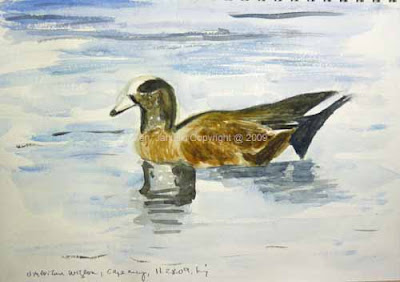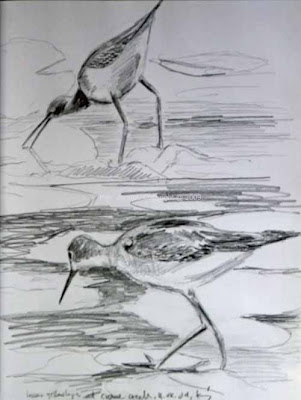
Just over a year ago I posted something on the pleasures of birding. It was illustrated by photos that I had just taken while on vacation in Cape May, NJ. But something bothered me about it. I had average looking photos. I would have preferred sketches drawn from life. This year I'm happy to say that photos are out and field sketches are in! Combining a new scope, for better viewing, and a determination to do more sketching from life I was finally able to come home with a fair number of sketches.
As field sketches go they could be better. We saw over 1000 Dunlins and yet I don't think I have one really good sketch of one. But with fieldsketching you really need to keep at it.
The top sketch shows a Common Eider seen near the Delaware Bayshore in Cape May, a Lesser Yellowlegs next to a Short-billed Dowitcher from The Wetlands Institute in Stone Harbor, a Great Blue Heron seen on Nummy Island, and an unidentified rabbit seen at 'The Meadows' in Cape May. The variety is indicative of what can be seen here.

More Common Eiders above, a bird we'd never seen before, along with a Western Sandpiper, a couple Dunlins, whose bill I never got quite right, and a Northern Pintail, which were both handsome and plentiful.

I do wish that I'd gotten more detail in my sketches but I think that will come with time. The lack of detail above takes away a bit from the Peregrine Falcon which landed at the top of a conifer just as we were heading back to our car at 'The Meadows' at Cape May, and a Merlin seen at the Bayshore in Cape May. Also shown are a Hooded Merganser and a Sanderling from 'The Meadows' and a Ruddy Turnstone from the Bayshore.


American Coots appear in the two sketches above. One shows white spots on their rumps which I'd never seen before. One was seen at 'The Meadows', and the other at Cape May Point State Park. In Cape May and I think on many birding trips a short hike often takes hours if you see a number of birds. Such was the case with our hike at the State Park. There we also saw numerous American Wigeons, shown above, and a number of Ring-Necked Ducks, which were the first we'd ever seen. We also saw a number of Sanderlings along the Atlantic Ocean part of 'The Meadows.' The other drawing is a landscape that might serve as background for more developed work.

One other treat to see, this time at Brigantine, more formally known as the John Forsythe National Wildlife Refuge, was an American Avocet. He was situated in the water in such a way that his legs were almost completely underwater so that he looked more like a duck than the long-legged Avocet. But once he was in the scope there was no doubt as to what he was. He is in the sketch above along with one of many Ruddy Ducks that we saw at The Brig.

Another surprise at The Brig were a number of Black-crowned Night Herons. Most were immatures with just one adult. They also hid themselves among the shrubs so that at first you didn't see them, except for one immature who was out in the open preeing himself. Both the adult and the preening immature are shown above. The adult is incomplete because he was so buried in the vegetation.

As I said earlier there were at least one thousand Dunlin at Brigantine on our first visit. And yet I just couldn't get a drawing that seemed right. Part of this was due to the fact that they were so actively feeding, their head pointed down, bill constantly prodding the mud for food. The sketches above show some of my many attempts to get a good Dunlin drawing. I also did take photos so at some point I'll take a look at them and probably do a more developed work, based on both photos and fieldsketches, that does a better job on them. The virtue of fieldsketching, as I've said before, is that you learn how much you don't know. And then you set about learning it. There continues to be something exhilarating about this.


The last two sketches above show a Yellow-Rumped Warbler, a Northern Pintail preening itself, a brief glimpse of what I thought was a Pectoral Sandpiper, a Northern Shoveler, some Semi-palmated Plover, and, of course, another Dunlin.
I apologize for the quality of the photos. It's been dark and gloomy since we got back to Philadelphia and the natural light has been nearly nonexistent. But even the dark photos I think indicate just how rich birding, and nature in general, are in the Cape May area. I and my wife both feel very fortunate to live so close to it.






































